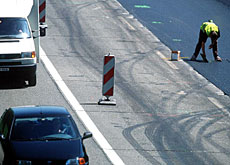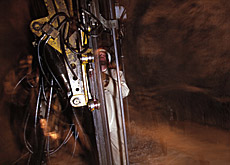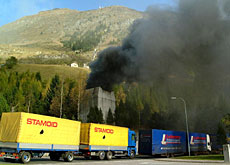Technology holds key to congestion

The Easter holiday traditionally heralds the year's first major traffic jams at the Gotthard tunnel - the main north-south axis through the Swiss Alps.
But technology is set to come to the rescue of motorists desperate to avoid congestion.
Although its use is not yet widespread, transport telematics is likely to be an important part of Switzerland’s future transport policy, according to a recent report by the Swiss centre for technology assessment (TA-Swiss).
The system provides in-car traffic information to help drivers get from A to B as quickly as possible.
Katrin Schneeberger, the report’s author, insists that it is essential to launch a public debate about how technological advances and the “networked vehicle” can solve increasing snarl-ups on the road.
She says networked vehicles would be able to share information with each other, directing motorists to less congested roads.
“A lot of cars have gadgets nowadays which use [telematic] systems,” she told swissinfo. “These can show the driver roads where there is no congestion or the shortest route between two points.”
Electronic gadgets
Schneeberger admits that at the moment not all cars are fitted with electronic gadgets as standard, but that could well change in the near future and would have a dramatic effect on people’s driving.
“The time is not far away when all cars will have telematic equipment,” she said. “Eventually motorists will not be able to choose the route they take – their car will ‘tell’ them.”
One form of transport telematics that already exists in Switzerland is at the Gotthard tunnel, where traffic is regulated by an electronic system that “drip feeds” vehicles through at a set rate.
When the number of vehicles threatens to exceed safety levels, lorries are required to queue before being allowed through.
It is also used on Swiss railways, where the European Control Train System provides electronic sharing of information that regulates the distances between trains and allows security levels to be maintained.
Tolls
Traffic congestion in Switzerland is not just confined to peak holiday periods. It is also a daily problem in cities throughout the country, albeit on a smaller scale than in many other parts of Europe.
One possible solution, especially in urban areas, would be the introduction of a road pricing system similar to the one launched recently in London.
But Sergio Bellucci, the director of TA-Swiss, admits that introducing such a system could take some time.
He says requiring motorists to pay for the use of certain roads in built-up areas during peak times would not be popular unless the public could see concrete advantages.
“I could imagine that at some time in the future we could introduce such a system,” he said. “But for the moment we have to see how it works in cities such as London and Oslo, and later perhaps how it could be adapted to Swiss requirements.”
Road pricing
Andreas Gantenbein from the Federal Roads Authority says the issue of road pricing will not be addressed for at least the next ten years as it has already been dropped from internal policy recommendations at the transport ministry.
The real solution to reducing the number of vehicles on the road, according to Bellucci, lies in changing people’s attitudes.
He says that even though Switzerland has a good and reputable public transport system, people rely too much on their cars.
“It’s vital to change our attitude towards the car,” he said. ” We need to encourage people to use other modes of transport.
“Figures in recent years indicate that people are likely to choose the car over any alternative, and we need to make it easier for them to change their behaviour.”
Traffic flows
Schneeberger says there are already some pilot schemes in place that use telematics, in particular to reduce the number of cars on the roads.
In the town of Burgdorf, just outside the capital Bern, for example, people can use a series of touch screens to register for car sharing.
Although she insists it is a move in the right direction, Schneeberger says that holiday jams at the Gotthard may be more difficult to solve – even with telematics.
“I think congestion may always take place [at the Gotthard],” she admitted. “It seems to be a sort of culture as though people like these traffic jams.
“But for those who want to avoid them, telematics could well provide them with alternative routes.”
swissinfo, Jonathan Summerton
There are around 3.6 million cars registered in Switzerland.
Transport telematics collects and distributes data aimed at improving traffic flows.
Only 23.5 per cent of people use public transport to get to work each day compared to 51.8 per cent by private transport.

In compliance with the JTI standards
More: SWI swissinfo.ch certified by the Journalism Trust Initiative


You can find an overview of ongoing debates with our journalists here. Please join us!
If you want to start a conversation about a topic raised in this article or want to report factual errors, email us at english@swissinfo.ch.